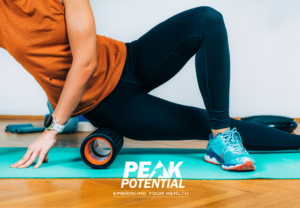Whether you are weekend warrior or competitive athlete, you are at risk for hamstring injury and you may never see it coming. But, when it happens . . . it sure is painful!
A hamstring strain is usually sudden, with an immediate sharp pain in the back of the thigh. Clients describe it as though something has “clasped the back of your leg” so tightly that it’s not impossible to move and horribly painful.
I remember my husband walking off the soccer field holding the back of his leg complaining of a “charlie horse”. When he turned around, I saw the back of his thigh start to bruise and swell. I had to break it to him that it wasn’t a muscle cramp. . . he tore his hamstring and sat on the side lines for a few games.
The amount of pain, immobility, and length of recovery is highly dependent on the severity of the muscle strain.
Three Degrees of Hamstring Injury:
With a minor strain you experience a cramping or “grabbing” sensation. People generally think they can walk it off, but that doesn’t quite do it. The pain usually goes away at rest, but comes back with activity.
A more significant tear will result in more pain. It comes on with a vice like grip as you run for a ball or set off on a sprint. In this case you can expect some form of swelling and visible bruising over the first few days.
A complete tear usually requires surgical repair, but fortunately is not very common. In this case, pain would be severe and you would be unable to walk on the affected leg.
So, assuming an injury that does not result in a complete tear. . . let’s recover quickly and get back to the game and back to life?
How to recover like the pros do:
1. Start off with some ice, compression, and rest for a few days. This minimizes swelling and bruising.
2. If the injury is not severe, try gentle activities like swimming or casual bike ride.
3. After the initial healing period, once swelling and bruising subside, stretching will be vital.
4. Massage is an important part of recovery to prevent scar tissue build up which can cause re injury when you return to activity.
5. Return to activity slowly and listen to your body. Expect some muscle “burning” . . . however, cramping and sharp pain should be avoided.
6. Exercises need to be progressed to work on the buttock and low back that assist the hamstring muscle to prevent re occurrence.
7. If returning to sports, an athlete needs to go through drills including sprints, shuttle runs, and plyometric work.
How Long Will I Be Sidelined?
This is dependent on injury severity, your recovery plan, and your bodies ability to heal.
With a minor strain, you may be able to continue to train and perform you regular activities with minimal modifications. However, a more severe tear make take several weeks of rest to recover and rebuild. Your individual case must be evaluated for an accurate estimate.
In any case, there is a fine balance between rest and activity. Too much activity delays healing, but too much rest increases the likelihood of re-injury.
The Pro Athletes Biggest Secret:
The secret of the professional is a team on board to assess the damage and guide activity level, stretching, and massage to promote healing. In fact, a professional soccer player may be seen by the team therapist or trainer several times a day for several weeks to ensure swift and proper recovery.
If you are interested in the “fast track” and want the best possible chance of not re injuring yourself when you return to play . . . Visit us for a Discovery Session to decide if physical therapy is the best choice for your injury and goals. Click HERE to get started for FREE.
If you choose to go it alone and after a few days are free from pain, remember this is not the cue to immediately go all in. Start back slowly to allow your body to adapt. Incorporate the suggestions above to allow complete healing.




